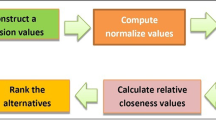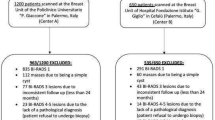Abstract
Medical image analysis plays an important role in computer-aided liver-carcinoma diagnosis. Aiming at the existing image fuzzy clustering segmentation being not suitable to segment CT image with non-uniform background, a fast robust kernel space fuzzy clustering segmentation algorithm is proposed. Firstly, the sample in euclidean space is mapped into the high dimensional feature space through the kernel function. Then the linear weighted filtering image is obtained by combining the current pixel with its neighborhood pixels through the space information in CT image. Finally, the two-dimensional histogram between the clustered pixel and its neighborhood mean is introduced into the robust kernel space image fuzzy clustering, and the iterative expression of the fast robust fuzzy clustering in kernel space is obtained by using Lagrange multiplier method. The experimental results on four databases show that our proposed method can segment liver tumors from abdominal CT volumes effectively and automatically, and the comprehensive segmentation performance of the proposed method is superior to that of several existing methods.






Similar content being viewed by others
References
Campadelli, P., Casiraghi, E., and Esposito, A., Liver segmentation from computed tomography scans: A survey and a new algorithm. Artif. Intell. Med. 45(2–3):185–196, 2009.
Tomoshige, S., Oost, E., Shimizu, A. et al., A conditional statistical shape model with integrated error estimation of the conditions; application to liver segmentation in non-contrast CT images. Med. Image Anal. 18(1):130–143, 2014.
Peng, J., Wang, Y., and Kong, D., Liver segmentation with constrained convex variational model. Pattern Recogn. Lett. 43(7):81–88, 2014.
Qian, P., Jiang, Y., Deng, Z., Lingzhi, H., Sun, S., Wang, S., and Muzic, Jr., R. F., Cluster prototypes and fuzzy memberships jointly leveraged cross-domain maximum entropy clustering. IEEE Transactions on Cybernetics 46(1):181–193, 2016.
Yang, H., and Zeng, J. H., A hierarchical local region-based sparse shape composition for liver segmentation in CT scans. Pattern Recogn. 50:88–106, 2016.
Moghbel, M., Mashohor, S., Mahmud, R. et al., Review of liver segmentation and computer assisted detection/diagnosis methods in computed tomography. Artif. Intell. Rev., 2017.
Norajitra, T., and Maier-Hein, K., 3D statistical shape models incorporating landmark-wise random regression forests for Omni-directional landmark detection. IEEE Trans. Med. Imaging 2016:1–1.
Anca, C., Xavier, B., Olivier, C. et al., Semi-supervised segmentation of ultrasound images based on patch representation and continuous min cut. PLoS One 9(7):e100972, 2014.
Thong, P., Abolmaesumi, P., and Hashtrudi-Zaad, K., Intra-subject elastic registration of 3D ultrasound images. Med. Image Anal. 10(5):713–725, 2006.
Kang, X., Ren, H., Li, J. et al., Computer-assisted bone tumour ablation using sparse radiographs. Adv. Robot. 28(5):303–315, 2014.
Wuttisarnwattana, P., Gargesha, M., Hof, W. V. et al., Automatic stem cell detection in microscopic whole mouse Cryo-imaging. IEEE Trans. Med. Imaging 35(3):819–829, 2016.
Liu, J., Wang, S., Linguraru, M. G. et al., Tumor sensitive matching flow: A variational method to detecting and segmenting perihepatic and perisplenic ovarian cancer metastases on contrast-enhanced abdominal CT. Med. Image Anal. 18(5):725–739, 2014.
Hoogi, A., Subramaniam, A., Veerapaneni, R. et al., Adaptive estimation of active contour parameters using convolutional neural networks and texture analysis. IEEE Trans. Med. Imaging 36(3):781–791, 2017.
Zheng, Y., Ai, D., Zhang, P. et al., Feature learning based random walk for liver segmentation. PLoS One 11(11):e0164098, 2016.
Qian, P., Zhao, K., Jiang, Y., Su, K.-H., Deng, Z., Wang, S., and Muzic, Jr., R. F., Knowledge-leveraged transfer fuzzy c-means for texture image segmentation with self-adaptive cluster prototype matching. Knowl.-Based Syst. 130:33–50, 2017.
Jiang, Y., Deng, Z., Chung, F.-L., Wang, G., Qian, P., Choi, K.-S., and Wang, S., Recognition of epileptic EEG signals using a novel multi-view TSK fuzzy system. IEEE Trans. Fuzzy Syst. 25(1):3–20, 2017.
Xuesong, L., Qinlan, X., Yunfei, Z. et al., Fully automatic liver segmentation combining multi-dimensional graph cut with shape information in 3D CT images. Sci. Rep. 8(1):10700–10712, 2018.
Mharib, A. M., Ramli, A. R., Mashohor, S. et al., Survey on liver CT image segmentation methods. Artif. Intell. Rev. 37(2):83–95, 2012.
Xiaomeng, L., Hao, C., Xiaojuan, Q. et al., H-DenseUNet: Hybrid densely connected UNet for liver and tumor segmentation from CT volumes. IEEE Trans. Med. Imaging:1–1, 2018.
Häme, Y., and Pollari, M., Semi-automatic liver tumor segmentation with hidden Markov measure field model and non-parametric distribution estimation. Med. Image Anal. 16(1):140–149, 2012.
Xia, K. J., Yin, H. S., and Wang, J. Q., A novel improved deep convolutional neural network model for medical image fusion. Clust. Comput. 28(3):1–13, 2018.
Chaieb, F., Ben Said, T., Mabrouk, S. et al., Accelerated liver tumor segmentation in four-phase computed tomography images. J. Real-Time Image Proc. 13(1):121–133, 2017.
Vorontsov, E., Tang, A., Roy, D. et al., Metastatic liver tumour segmentation with a neural network-guided 3D deformable model. Med. Biol. Eng. Comput. 55(1):127–139, 2017.
Smeets, D., Loeckx, D., Stijnen, B. et al., Semi-automatic level set segmentation of liver tumors combining a spiral-scanning technique with supervised fuzzy pixel classification. Med. Image Anal. 14(1):13–20, 2010.
Sun, C., Guo, S., Zhang, H. et al., Automatic segmentation of liver tumors from multiphase contrast-enhanced CT images based on FCNs. Artif. Intell. Med.:S0933365716305930, 2017.
Zygomalas, A., Karavias, D., Koutsouris, D. et al., Computer-assisted liver tumor surgery using a novel semiautomatic and a hybrid semiautomatic segmentation algorithm. Med. Biol. Eng. Comput. 54(5):711–721, 2016.
Xia, K.-j., Yin, H.-s., and Zhang, Y.-d., Deep semantic segmentation of kidney and space-occupying lesion area based on SCNN and ResNet models combined with SIFT-flow algorithm. J. Med. Syst. 43:2, 2019. https://doi.org/10.1007/s10916-018-1116-1.
Ruskó, L., Bekes, G., and Fidrich, M., Automatic segmentation of the liver from multi- and single-phase contrast-enhanced CT images. Med. Image Anal. 13(6):871–882, 2009.
Lee, W. L., Chen, Y. C., Chen, Y. C. et al., Unsupervised segmentation of ultrasonic liver images by multiresolution fractal feature vector. Inf. Sci. 175(3):177–199, 2005.
Hoogi, A., Beaulieu, C. F., Cunha, G. M. et al., Adaptive local window for level set segmentation of CT and MRI liver lesions. Med. Image Anal. 37(4):46–55, 2017.
Kaijian Xia, Hongsheng Yin, Pengjiang Qian, Yizhang Jiang, Shuihua Wang, Liver Semantic Segmentation Algorithm Based on Improved Deep Adversarial Networks in Combination of Weighted Loss Function on Abdominal CT Images. IEEE Access 7: 96349-96358 ,2019
Qian Zhao, Y., Hong Wang, X., Fang Wang, X. et al., Retinal vessels segmentation based on level set and region growing. Pattern Recogn. 47(7):2437–2446, 2014.
Tang, Z., Wang, S., Huo, J., Guo, H., Zhao, H., and Mei, Y., Bayesian framework with non-local and low-rank constraint for image reconstruction. J. Phys. Conf. Ser. 787(787):1–11, 2017.
Wang, G., Zhang, S., Xie, H. et al., A homotopy-based sparse representation for fast and accurate shape prior modeling in liver surgical planning. Med. Image Anal. 19(1):176–186, 2015.
Qian, P., Jiang, Y., Wang, S., Su, K.-H., Wang, J., Hu, L., and Muzic, Jr., R. F., Affinity and penalty jointly constrained spectral clustering with all-compatibility, flexibility, and robustness. IEEE Transactions on Neural Networks and Learning Systems 28(5):1123–1138, 2017.
Jiang, Y., Chung, F.-L., Wang, S., Deng, Z., Wang, J., and Qian, P., Collaborative fuzzy clustering from multiple weighted views. IEEE Transactions on Cybernetics 45(4):688–701, 2015.
Jiang, Y., Chung, F.-L., Ishibuchi, H. et al., Multitask TSK fuzzy system modeling by mining intertask common hidden structure. IEEE Transactions on Cybernetics 45(3):548–561, 2015.
Kajian, X., Jiangqiang, W., and Yue, W., Robust Alzheimer disease classification based on feature integration fusion model for magnetic[J]. Journal of Journal of medical imaging and health informatics 24(7):1–6, 2017.
Author information
Authors and Affiliations
Corresponding author
Ethics declarations
Conflict of interest
Author declares that he has no conflict of interest.
Research involving human participants.
Informed consent
Informed consent was obtained from all individual participants included in the study.
Additional information
Publisher’s Note
Springer Nature remains neutral with regard to jurisdictional claims in published maps and institutional affiliations.
This article is part of the Topical Collection on Image & Signal Processing
Rights and permissions
About this article
Cite this article
Cai, J. Segmentation and Diagnosis of Liver Carcinoma Based on Adaptive Scale-Kernel Fuzzy Clustering Model for CT Images. J Med Syst 43, 322 (2019). https://doi.org/10.1007/s10916-019-1459-2
Received:
Accepted:
Published:
DOI: https://doi.org/10.1007/s10916-019-1459-2




